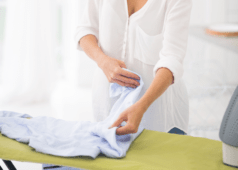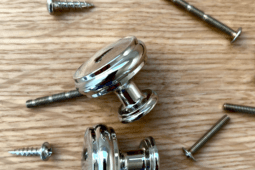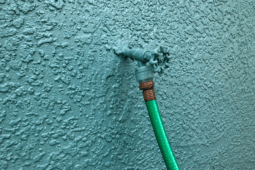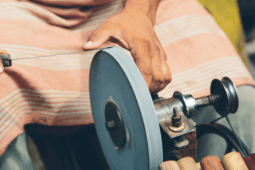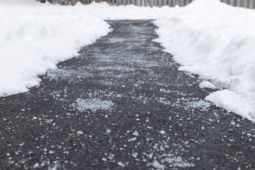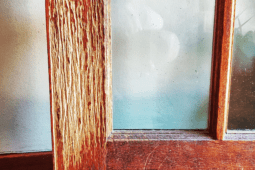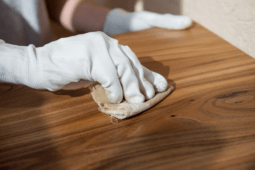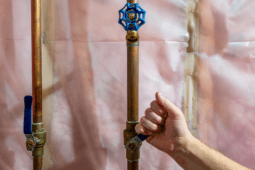How to: Make A Stylish $30 Bulletin Board
 I’ve had this extra frame sitting around the shop since my beer tasting party in November. It’s been in the way and I really needed to find a project to get it back to something useful. So I decided to turn it into a classy bulletin board for my notes, ideas, and inspiration.Since I’m moving into a new office space on Monday, I was looking around for some upgraded version of my shredded bulletin board. For this project, I took backing board and added cork material, then threw a nice textured fabric over half to give it a clean look. The entire board is still a functional cork board, but now it’s something I’m glad to have hanging in my new space. Here are all the pieces we’ll need:
I’ve had this extra frame sitting around the shop since my beer tasting party in November. It’s been in the way and I really needed to find a project to get it back to something useful. So I decided to turn it into a classy bulletin board for my notes, ideas, and inspiration.Since I’m moving into a new office space on Monday, I was looking around for some upgraded version of my shredded bulletin board. For this project, I took backing board and added cork material, then threw a nice textured fabric over half to give it a clean look. The entire board is still a functional cork board, but now it’s something I’m glad to have hanging in my new space. Here are all the pieces we’ll need:![credit: David [] Materials](https://s3.amazonaws.com/manmadediy-uploads-production/photos/24958/IMG_8536-2_large.jpg?1425881707)
Material List:
1. Frame (can be a simple photo frame, or something more complex). – $3-10
2. 1/4″ backing board, cut to fit frame – $5
3. 1/4″ cork squares I found mine here (and only used 1/2) – $12
4. 1 yard fabric, I used some navy herringbone I found at Jo-Ann Fabric – $5
5. 1 yard padded batting material – $3
6. Large button, small button & thread (I used a craft cover button from another project)
7. Staple gun
8. Multi-purpose glue
9. Yardstick and razor knife
Steps:
First, take the frame and measure out backing board for the opening. I have two openings, so I cut two pieces. Be sure to leave just a bit of play (about 1/8″ total on the top & side) so that the fabric can wrap around and it will still fit nice and tight. Drill holes at this time for all buttons you plan on installing.
![credit: David [] Cork Board](https://s3.amazonaws.com/manmadediy-uploads-production/photos/24959/IMG_8545-2_large.jpg?1425881769)
Next, set the cork onto the backing board and cut to fit. It’s important to keep the pieces tight, and be sure to cut them with a very sharp blade to keep from chipping the flaky material. After it is all cut to size, secure down with an even layer of multi-purpose glue. Make sure to use enough glue so that the entire surface is glued down consistently.
![credit: David [] Batting for board](https://s3.amazonaws.com/manmadediy-uploads-production/photos/24961/IMG_8548-2_large.jpg?1425881867)
After the glue is dry(ish) you can lay out and cut the batting material. Cut the padded material to fit right to the edge of the backing board. This material does not need to be glued down.
Next, lay down the board on the material and cut it about 1/2″ wider than the board on all sides. Make sure you have enough material to stretch all the way to the back and still have enough to staple it on without the material tearing. Lay the material face down, then the batting, and then the backing board with the cork face down. line up all the pieces and check for wrinkles or folds.
![credit: David [] Stapling on fabric](https://s3.amazonaws.com/manmadediy-uploads-production/photos/24962/IMG_8552-2_large.jpg?1425881919)
Once it is all laid out, evenly pull the material over one side and staple down about 1″ from the edge every 2-3″. Stretch the materials tightly over the opposite edge and staple the same along that side, working from the center towards the edges checking for an even stretch across the entire pieces. Don’t worry about the very corners until the end, just get it stapled tight within 2″ of the corners. It’s important to not stretch too tight, make sure it’s even along the entire edge to avoid a visible line. Do the same for both of the sides.
![credit: David [] Finished cork board fabric](https://s3.amazonaws.com/manmadediy-uploads-production/photos/24963/IMG_8557_large.jpg?1425882007)
After all sides have been evenly secured, work on the corners. Pull it tight, then pull it to one side and staple right in the corner. Then pull to the other side and do the same. Lastly, evenly pull it towards the center and staple it tight.
Adding the button means threading a needle with heavy thread or (or fishing line) then pushing from the back through the material. Thread the large button on the front then pull back through to the back. On the back, pull tight and secure with the smaller button.![credit: David [] Stapled In](https://s3.amazonaws.com/manmadediy-uploads-production/photos/24964/IMG_8575-2_large.jpg?1425882066)
At this point, the board should be ready to install in the frame. I used staples bridging the board and frame to hold it all together. Add a few hangers if needed and the board should be ready to throw up on the wall and enjoy.
![credit: David [] Finished Board](https://s3.amazonaws.com/manmadediy-uploads-production/photos/24965/IMG_8569_large.jpg?1425882110)
A quick note on Upholstery – This project uses a few basic upholstery skills that can be used for plenty of projects around the shop. Adding fabric to a project opens up so many options for better design, use, and overall style. I encourage you to go flip over a few pieces of your furniture and take a look at how they put it all together. It’s a huge eye opener when you realize how much work goes into crafting that easy chair.


